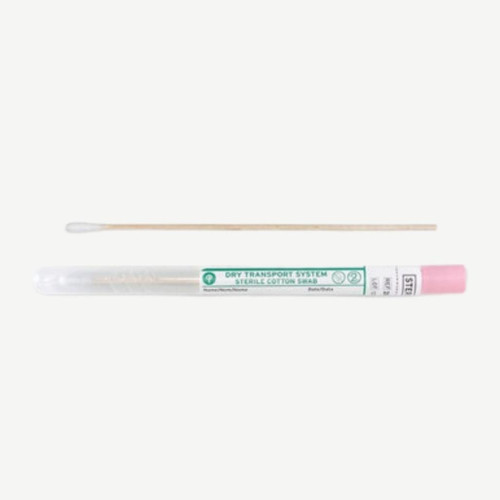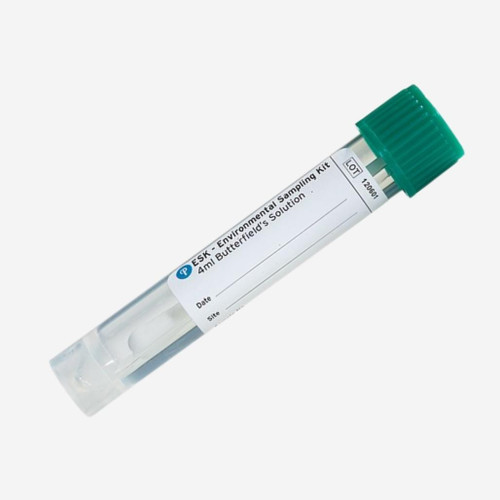-
Puritan Medical
SKU: 25-1506-1PF-BT
Puritan 25-1506 1PF BT BL Sterile Foam Swab, Plastic Shaft, Transport Tube
Sterile: YesOverall Length: 6 in.Tip Material: FoamShaft Material: PolystyreneTransport Tube: YesCountry of Origin: USA$91.29 - $389.99Usually Ships Same Business Day -
Puritan Medical
SKU: 25-805-1PC-TT-FABUSA
Puritan Sterile DNA Controlled Cotton Swab with Transport Tube, 50/box
Sterile: YesOverall Length: 6 in.Tip Material: CottonShaft Material: PolystyreneTransport Tube: YesCountry of Origin: USA$102.29 - $844.99Usually Ships Same Business Day -
Puritan Medical
SKU: 25-806-1WC-EC
Puritan Cap-Shure 6" Sterile Standard Cotton Swabs, Wood Shaft, 50/box
Sterile: YesOverall Length: 6 in.Tip Material: HydraFlockedShaft Material: WoodTransport Tube: YesCountry of Origin: USAIndustry: Diagnostics/Specimen CollectionIndustry: Forensics/Genetics$51.69 - $454.99Usually Ships Same Business Day -
Puritan Medical
SKU: P25-3606-U-BT-FABUSA-F
Sterile PurFlock Ultra Flocked DNA Free Forensic Swab, Elongated Tip, 500/case
Sterile: YesOverall Length: 6 in.Tip Material: Ultra FlockedShaft Material: PolystyreneTransport Tube: YesCountry of Origin: USA$789.99Ships within 1-2 Business Days -
Puritan Medical
SKU: 25-3306-H-BT
Puritan 25-3306-H BT Sterile HydraFlock Flocked Swab with Transport Tube, Regular Tip, 100/box
Sterile: YesOverall Length: 6 in.Tip Material: HydraFlockedShaft Material: PolystyreneTransport Tube: YesCountry of Origin: USA$104.49 - $464.99Ships within 1-2 Business Days -
Puritan Medical
SKU: 25-806-1WC-BT
Puritan Sterile Regular Tip Cotton Swab, Wood shaft, Transport Tube, 100/box
Sterile: YesOverall Length: 6 in.Tip Material: CottonShaft Material: WoodTransport Tube: YesCountry of Origin: USA$0.00 - $76.99Usually Ships Same Business Day -
Puritan Medical
SKU: PUT-117-CS
Puritan UT-117 UniTranz-RT, 1ml, Ultrafine Tip (Nasal Swab), 300/case
Sterile: YesOverall Length: 6 in.Tip Material: Ultra FlockedShaft Material: PolystyreneTransport Tube: YesCountry of Origin: USATip Diameter: 0.14" (3.556 mm)$504.99Ships within 1-2 Business Days -
Puritan Medical
SKU: 25-806-1PC-EC
Puritan Cap-Shure© Sterile Cotton Swab, 6 in., Polypropylene Shaft, 50/box
Sterile: YesOverall Length: 6 in.Tip Material: CottonShaft Material: PolystyreneTransport Tube: YesCountry of Origin: USA$52.79 - $464.99Usually Ships Same Business Day -
$70.99Ships within 1-2 Business Days
-
Puritan Medical
SKU: PSP-100-P
Puritan 1ml Sputum Medium with Transfer Pipette, 20/box
Country of Origin: USA$57.99Ships within 1-2 Business Days -
Puritan Medical
SKU: 25-83004-PD-NB
EnviroMax Plus Sampling Kit with Neutralizing Buffer, 4 mil and 10 mil
Sterile: YesOverall Length: 4 in.Tip Material: PolyesterShaft Material: PolystyreneTransport Tube: YesCountry of Origin: USA$91.29 - $419.99Ships from Manufacturer -
$102.99 - $109.99Ships from Manufacturer
-
Puritan Medical
SKU: PUT-116-CS
Puritan UniTranz-RT, 1ml, Mini-Tip, 300/case
Sterile: YesOverall Length: 6 in.Tip Material: Ultra FlockedShaft Material: PolystyreneTransport Tube: YesCountry of Origin: USATip Diameter: 0.135"" (3.429 mm)$554.99Ships within 1-2 Business Days -
Puritan Medical
SKU: PUT-100-case
Puritan 1 ml Universal Transport Medium, 300/case
Country of Origin: USACase Quantity: 300$394.99Ships within 1-2 Business Days -
Puritan Medical
SKU: PUT-106
Puritan UT-106 UniTranz-RT, 1ml, Large Tip, 300/case
Sterile: YesOverall Length: 6 in.Tip Material: Ultra FlockedShaft Material: PolystyreneTransport Tube: YesCountry of Origin: USATip Diameter: 0.219"" (5.563 mm)$514.99Ships within 1-2 Business Days -
Puritan Medical
SKU: PVL1201-SAFE
Puritan 1 ml DNA/RNA PurSafe Transport Medium, 300/case
Sterile: YesOverall Length: 6 in.Tip Material: HydraFlockedShaft Material: PolystyreneTransport Tube: YesCountry of Origin: USA$759.99Ships within 1-2 Business Days -
Puritan Medical
SKU: PUT-316
Puritan UT-316 UniTranz-RT, 3ml, Mini-Tip, 300/case
Sterile: YesOverall Length: 6 in.Tip Material: Ultra FlockedShaft Material: PolystyreneTransport Tube: YesCountry of Origin: USATip Diameter: 0.135"" (3.429 mm)$674.99Ships within 1-2 Business Days -
Puritan Medical
SKU: 25-83004-PD-BS
EnviroMax Plus Sampling Kit with Butterfield's Solution, 4 mil and 10 mil
Sterile: YesOverall Length: 4 in.Tip Material: PolyesterShaft Material: PolystyreneTransport Tube: YesCountry of Origin: USATip Diameter: 0.203" (5.156 mm)$91.29 - $419.99Ships from Manufacturer -
Puritan Medical
SKU: PUT-300-case
Puritan UT-300 3 ml Universal Transport Medium, 300/case
Country of Origin: USA$554.99Ships within 1-2 Business Days -
Puritan Medical
SKU: PCB
Puritan Cary-Blair Transport Medium, 50/box
Box Quantity: 50Country of Origin: USASterile: Yes$91.29 - $96.79Usually Ships Same Business Day -
Puritan Medical
SKU: 25-83004-PDBPW
EnviroMax Plus Sampling Kit with Buffered Peptone Water, 4mil or 10 mil
Sterile: YesOverall Length: 4 in.Tip Material: PolyesterShaft Material: PolystyreneTransport Tube: YesCountry of Origin: USATip Diameter: 0.203” (5.156 mm)$91.29 - $414.99Ships from Manufacturer -
Puritan Medical
SKU: 25-83004-PD-LB
EnviroMax Plus Sampling Kit with Letheen Broth, 4 mil and 10 mil
Sterile: YesOverall Length: 4 in.Tip Material: PolyesterShaft Material: PolystyreneTransport Tube: YesCountry of Origin: USATip Diameter: 0.203” Dia. (5.156 mm)$91.29 - $454.99Ships from Manufacturer -
Puritan Medical
SKU: PVL1201-SAFE-H
Puritan PurSafe® 1ml Molecular Preservative and 6 in. Sterile Large Flock Swab, 300/case
Country of Origin: USA$1,144.99Ships within 1-2 Business Days -
Puritan Medical
SKU: P25-806-1PC-BT-FABUSA
Puritan Sterile DNA Controlled Cotton Swab with Transport Tube, 500/case
Sterile: YesOverall Length: 6 in.Tip Material: CottonShaft Material: PolystyreneTransport Tube: YesCountry of Origin: USA$819.99Ships within 1-2 Business Days


























